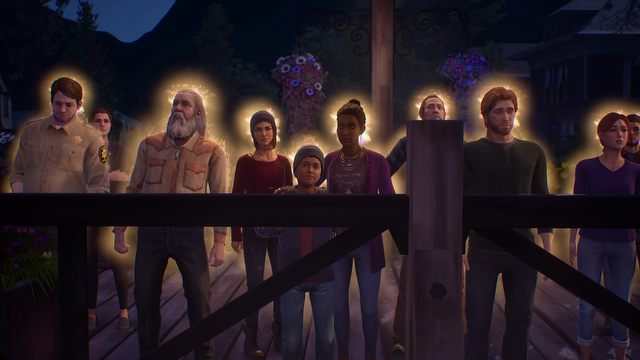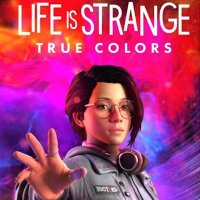Life is Strange True Colors Review: A Rainbow of Emotions
If you had the power to find out how someone was feeling, would you try to help them or worry about your own problems instead? This question is one of many Alex Chen faces in another great entry in the Life is Strange series.
The review is based on the PS5 version. It's also relevant to PC, PS4, XONE, XSX version(s).

Life is Strange is known for being a series that incorporates a supernatural element into the everyday life of young adults by giving them a superpower during an intense moment in their life. This power often becomes the catalyst that stirs up the story and allows us to follow these teenagers as they learn how to deal with their newfound abilities and how it affects the world around them.
- A rich, choice-driven narrative;
- Multidimensional characters to get to know;
- Wonderfully acted, emotional cutscenes.
- Some story outcomes feel too convenient to be believable;
- Shorter than its past episodic entries.
In True Colors, protagonist Alex Chen is already aware of her power, and what sets up the central conflict in the story isn’t related to her psychic abilities at all. Instead, the game focuses on a central tragedy and has her powers be the tool that helps her get to the truth behind what happened while also influencing and helping those she meets. This makes for a Life is Strange game that has all the qualities we come to expect from the series but is enhanced by its strong storytelling elements and rich cast.
A human mood ring
Alex’s power lets her feel the emotions of those around her and read how they are feeling due to colorful auras that surround them in moments of high-intensity. Blue represents sadness, purple indicates fear, yellow is joy, and a red aura shows off the anger in someone’s heart. Compared to past games, her power isn’t as cool as, say, being able to rewind time or move things with your mind.
Instead, her power is more passive and is all about understanding the emotions of others, a fitting ability for a game that deals with some heavy subject matter and continues with the themes the series is known for.
Her story begins following a troubled past filled with counselors and foster homes. She is now an adult and gets to reconnect with her older brother who invites her to visit him in the picturesque town of Haven Springs, Colorado. The two haven’t seen each other in years, but their reunion is short-lived after an unfortunate accident shakes up the town. Haven Springs becomes the setting of a murder mystery, and its residents become suspects, allies, and the family Alex needs at that very moment.
Choice-driven narrative
The game is a choice-driven narrative so you can choose various replies whenever you engage with the characters you meet throughout town. This allows you to shape how people perceive Alex or how she replies to certain questions during conversations. She can be doubtful, polite, or sarcastic, and characters will “remember that” every so often. Your choices shape future dialogues allowing the story to mold to your choices.
Some are simple like choosing to take a shot at a bar or be a good employee and tend to your customers instead. Others are more impactful, like forgiving someone or condemning them for their cruel actions, and the game even warns you by how these moments are shown on screen. Like in past games, these choices can affect future events or how certain scenarios play out, which make these decisions even more crucial.
Of course, there is no right or wrong way to play True Colors. Each choice leads to branching scenarios, which allow you to enjoy the story on your own terms. You won’t know what impact you would have had unless you play the game a second time, for instance, so you always get the story that fits your version of what’s good or bad. Be forgiving. Be vengeful. Be flirty. Just be you.
Right in the feels
On top of these decisions, there are also moments in both the main story and in side interactions that let Alex use her powers to learn more about a person and discover something new about them. Some of these are optional, but finding a glowing aura around a person on the street and reading into how they are feeling adds another layer to the community of Haven Springs and even opens up an optional way of helping them. Who knew helping a guy cheat at a jelly bean guessing contest to use the money to buy doggie treats could feel so fulfilling? That is, if you helped him find his dog earlier in the story, of course.
Besides simply peering into someone’s emotional thoughts, other moments also let you enter that person’s heart and find out what is troubling them to relieve them of their fear or anger. These moments have Alex entering an alternate reality of sorts and scanning the objects around her to piece together why that person is suffering. These moments are filled with emotion – no pun intended – and add that magic realism the games are known for.
Rich in colors and personality
Learning more about a person also involves a lot of backstory and flashbacks, and True Colors is filled with these. Whether they come in the form of a flashback Alex has when she reads a person or from her journal that she updates as the game progresses, there is a lot of lore about Alex and her community to dive into, more so than in previous games which focused primarily on its main characters.
Each of the various townspeople you meet is a multifaceted, and by the end of the game you learn not to judge a book by its cover. What’s even more important is how Alex can learn more about them and help them out, even by a little, in whatever is ailing them. Issues like parenting, Alzheimer’s, death, and even corporate corruption are touched on here and they all fit into the tapestry of what makes Haven Springs so colorful – literally, too.
Its vibrant visuals and impressive cutscenes that capture the raw emotion a character is feeling turn Haven Springs into that melodrama on TV you want to keep watching. There is so much detail everywhere you go that it makes you stop and examine every little decoration on a table or sign taped onto a wall wondering what it says. These small touches breathe life into its small yet curious world. Its soundtrack also contains lots of indie sounds that further give it that laidback, hipster vibe the series continues to gravitate to. There are even acoustic covers to popular music that also help connect the game to our reality.
Flawed, but one of the best
Unlike past titles in the series, True Colors is one full game, so you can binge the entire story instead of waiting months for the next episode. The game is still segmented into chapters which recap your choices and compares them to other players. Each chapter has enough action and good pacing that keeps them intriguing, but each chapter does tend to feel shorter than you would hope and the game can easily be completed in about 12 hours.
While possibly being a highlight of the entire series, its story does have some moments that cast doubt on how believable some of it actually is, even for Life is Strange’s standards. Yes, you play as a psychic empath, but near the end of the game, you discover some truths that are just too convenient to be real, and things fall into place too neatly. Also, Alex first tells us that she can only see emotional auras when people are at their peak, but soon you can read various people who seem pretty calm or when it becomes convenient for the purposes of the story.
These small flaws aside, True Colors tugs at your heartstrings and doesn’t let go until the end credits roll. It’s a wholesome game that covers some deep subject matter, but gives it to you in a way that makes for an enjoyable viewing and gaming experience. Fans of the series will love how familiar it feels to the other games, but everyone will appreciate how mature its themes are, continuing to emphasize the uniqueness and unexpectedness that life can bring – superpowers in hand or not.
Life is Strange: True Colors
Life is Strange True Colors Review: A Rainbow of Emotions
If you had the power to find out how someone was feeling, would you try to help them or worry about your own problems instead? This question is one of many Alex Chen faces in another great entry in the Life is Strange series.









